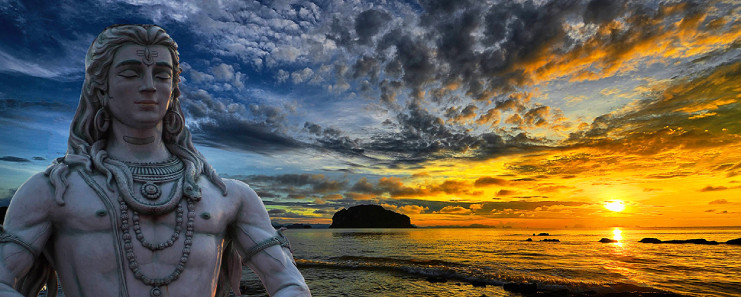Significance of Mahashivratri
Ever thought why is Shiva the subject of such deep wonder and worshipped so widely in India? Could Shiva be an actual person? Does divinity possess a human form ? And would it be limited if that divinity was in a human body?
What if we tell you that your life has a hint of Lord Shiva? What if we tell you that when you catch this particular aspect of life, then you can achieve Shiva? Would you believe if we tell you that Shiva is nothing but that deep state of peace, calmness and inner stability?
Well, whether you believe it or not, it is true. Let’s explore Shiva, it’s symbolism, the significance and essence of Mahashivratri.
Our culture, traditions, and festivals have a deeper meaning. All of them are associated with a specific divine energy. This divine energy is given a name and form for us to understand the virtues, qualities, and its blessings clearly. One among these energies, and the presiding energy, is Shiva.

Is Shiva a person?
The word Shiva simply means mangalam (auspicious). In fact, the term Shiva has a much larger connotation which includes:
- having the potential
- being capable of
- boding well
- being favorable or promising.
Shiva can be split into:
- Sha + ee + Va
- Sha stands for shareeram or body
- ee stands for eeshwari or life giving energy
- Va stands for vayu or motion.
If the ee is removed from Shiva, it gets reduced to sha+va or shava, which means a lifeless body. We also use the term shavasana in yoga, where one is motionless and in an absolute state of rest.
While Shava is motionless or lifeless, Shiva is with the potential of life. Anything with Shiva is with life and anything without Shiva is shava: lifeless.
So, Shiva is auspicious, Shiva is life and Shiva is potential. Shiva is all-encompassing - the universal soul or consciousness. This realization of the eternal fact that Shiva is an energy, tattva, leads to ananda, bliss.
However, for centuries, Lord Shiva’s form (pictorial depiction) has been romanticized by historians and devotees alike. A body smeared with ash, a tiger skin encircling his loins, a crescent moon adorning his forehead, matted hair piled high on his head from where the celestial river Ganga flows, one hand holding the trident, other set in a classical mudra. Sometimes he is playing the dumroo as he is consumed in the cosmic dance. The third eye between the brows accentuating his bold handsomeness, snakes encircling his azure neck. This image in its evocativeness has never failed to attract and arouse the curiosity within.
As many metaphors there have been to describe the visual appearance of Shiva, there are more names to describe the attributes that he is known to embody. The 1008 names of Shiva only serve to portray his infinite and versatile nature, his unknowable mystery, which is devoid of polarities, composite and synthesized. Yet, he is beyond description or definition.
Lord Shiva can only be experienced and lived through.
Mahashivratri: The night of Shiva
The most sacred festival of Shiva falls on the 14th night of the new moon, during the dark half of the lunar month of Phalguna. This is some time between February and March. This is Mahashivratri or the great night of Shiva.
Devotees of Shiva stay awake the entire night on this auspicious night of Shivratri. Some perform poojas, chant Vedic mantras or Rudram, practice sadhana and meditation. These sacred practices bestow a sense of peace within us and oneness with the world.
“Every Mahashivratri is meant to wake up every particle of your body. The festival is a wake-up call to move away from conflicts and move towards truth, beauty, peace, and benevolence - the ethereal qualities of Shiva.”
- Gurudev Sri Sri Ravi Shankar

Why is Mahashivratri celebrated?
There are many stories around Shiva. While each of these stories is meaningful, Gurudev sheds light on the significance of Mahashivratri. He says, Shiva is not a person, but the very energy on which the entire creation rests. This energy pervades the entire universe and is present within every living being. This energy is called the Shiva Tattva.
Meaning of Mahashivratri
Ratri means that which gives rest, and comforts you. Night is when all activities stop. Everything is quiet and peaceful. The environment becomes calm and the body naturally goes into sleep/ rest mode.
Ratri also means that which gives relief from the three types of problems: problems to the body, to the mind and to the soul - adhyatmik, adhibhoutik, and adidaivik. When you are sleeping at night, you are not worried about food, water or clothing. All that you want is to sleep so that it gives you relief from the worries of the day.
Hence, the three types of peace are needed, to even get that deep rest: first is material peace. If there is fighting around you, or any disturbance around, then you can’t sleep/ rest. Second, you need peace in the body, mind. Third, you need peace in the soul. Without any one of the three, deep rest is incomplete. So, that which gives rest from all three aspects- physical, mental and spiritual is ratri/ night. And Shivratri is the night of that transcendental divine consciousness, which brings solace to all layers of consciousness. This night is symbolic of the merging of Shiva and Shakti, making the environment more alive. Thus it is beneficial to stay awake on Mahashivratri.
This night brings a sense of deep serenity and benevolence. Any meditation done on this day is a hundred times more effective.
It is also astrologically linked: when the sun and moon are in a particular alignment, it helps to elevate the mind. Ancient seers said such days were congenial for spiritual practices. According to Indian astrology, there are certain days and time frames in a year that are conducive to spiritual growth and meditation. Mahashivratri is one such day.
Mahashivratri is the wedding of the material and spiritual. It is said that the Shiva tattva (principle/ energy) is, generally, ten inches above the material ground. On this day, this consciousness descends and touches the earth element. It is a good time for our inner consciousness to come alive within our body. That is why a spiritual seeker has a special significance for Mahashivratri. When such subtle all-pervading energy unites with the earth, it helps achieve a deeper and enriching experience of meditation.
Importance of meditation/ sadhana on Mahashivratri
Mahashivratri is a time to celebrate the Shiva tattva. Spiritual seekers and devotees of Lord Shiva meditate and rejoice in the Shiva energy. Shiva represents our soul, and tattva is a principle or truth. This is that time of year when we rest in the truth/ principle of our soul. It means we are seeking the higher truths of life that are lying within us.
It is a time for sadhana, a deep rest for the body, mind, and ego. That deep rest which awakens a devotee to the highest knowledge of the Shiva Tattva.
Meditation gives us access to something that is beyond the scope of the mind and intellect. There is a point during meditation when we can experience space: a space of nothingness and love. This experience takes us to the fourth level of consciousness that is also called Shiva.
“When one has access to mystical realms through deep sadhana and detachment to the material world, one is able to experience the Ananda Tandava. There are multiple dimensions of existence. One who has gained entry to the subtle realms of creation will find that the dance of Shiva is happening in a ceaseless continuum. This blissful dance of the cosmic rhythm can be enjoyed only after transcending the body, mind, intellect and ego complex.”
- Gurudev Sri Sri Ravi Shankar
In a nutshell
- It is believed that praying on Shiva on the day of Mahashivratri blesses one with benevolence and prosperity as Shiva is revered as Mahadev.
- Shiva is the soul of everything.
- Mahashivratri is an occasion to remember the eternal truth of Shivoham, meaning ‘I am that principle. I am Shiva. I am the truth, benevolence, eternity, beauty.’
- Mahashivratri is a New Year for spiritual seekers. It is considered as an auspicious day for spiritual growth and material attainment. On this night, when the constellations are in a favourable position, it is very auspicious for meditation. Hence meditating is considered to be the most important aspect to experience the Shiva tattva.
- In ancient times, people used to say if you cannot meditate consistently, even then do it at least once in a year. On Mahashivratri, stay awake and meditate. Wake the divinity that is within you.
- When we chant Vedic mantras, these mantras bring a big change in the environment. It brings purity to the environment, positivity is increased, bad karmas are destroyed, and celebration dawns within and in nature. That is why Rudraabhishekam has been performed for thousands of years. It is recommended to chant/ listen to Rudra Puja on Mahashivratri.
- Eating light food, chanting, meditating, realizing the presence of Shiva as a tattva permeating through the universe and within us is the crux of Mahashivratri.
This year, you can experience the Shiva tattva effortlessly with Gurudev Sri Sri Ravi Shankar on March 1. Join us and experience the magical significance of Mahashivratri for yourself!
Based on inputs from Bharath Gyan and knowledge talks by Gurudev Sri Sri Ravi Shankar
To watch LIVE webcast of Mahashivratri celebrations with Gurudev on March 1st, click here.
We’d love to hear from you.
Leave your comments @artofliving
Join us for Mahashivratri at the Art of Living International Center. Listen to the magnificent Rudram, chant Om Namah Shivaya and meditate at midnight with millions of people.







































